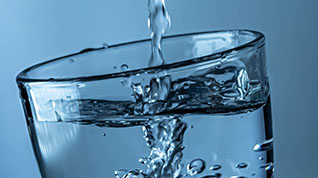



Sparkling water, known for its refreshing fizz, is a popular alternative to still water — but is it just as hydrating? Dietitians confirm that sparkling water, also called carbonated or seltzer water, provides the same hydration benefits as still water because both are essentially H2O. Research supports this, showing that carbonation doesn’t interfere with hydration, making sparkling water a solid option for reaching daily water intake goals.
Dr. Margaret McCartney, a general practitioner from Scotland, says that the common health advice that you should drink six to eight cups of water each day is "thoroughly debunked nonsense". She argues that it is propagated by bottled water companies out to make a profit.
Water qualities
The sources from which drinking water can be obtained are:
• Hyporheic zones and groundwater conductors using a fountain
• Rain, including rain, hail, snow, fog, etc.
• surface water such as sources, rivers, streams and glaciers
• Sea water (desalmed)
• Biological sources such as plants
• Water supply networks
• Atmospheric water producers
• Urine, moist waste, exhaust air and moist soil - through distillation
Natural mineral water, spring water and healing water come from underground deep water. Since the water does not get to the surface by itself, it has to be pumped up from the fountain. All types of water taste different depending on the composition and concentration of the minerals. Each individual is subject to different requirements.
Natural mineral water
Natural mineral water comes from underground water deposits and is filled directly at the source location. The purity of this water arises from living microorganisms and mechanical cleaning of gravel and stone for many years. Natural mineral water requires official recognition and usage permit. Components such as Iron or sulfur compounds are removed and carbon dioxide is added. Depending on the carbon dioxide content, the mineral water is divided into classic, medium or quietly.
Spring water
Spring water must come from an underground water deposit like natural mineral water and be filled on site. However, it does not require official recognition and proof of the original purity.
Table water
Table water consists of drinking and/or natural mineral water and additives such as minerals, sea water or table salt. Tafel water can also be served openly, e.g. from tap systems in restaurants or in drinks machines. Mineral water, on the other hand, has to be served in a bottle.
Healing water
Healing water is a natural water that has healing or disease -relieving properties. This effectiveness must be confirmed, so it is not one of the food, but one of the drugs. Healing water is subject to strict approval obligations, but is not subject to prescription. The provisions of drug law apply.
Juvenile water
Juvenile water is a water from the interior of the earth, which was never previously atmospheric water or surface water. In the typology of healing water , the "type 1" is described as water - possibly as a juvenile water - from large earth depths that can be several kilometers of the size.
Filling
Natural mineral water, healing water and spring water access the original packaging, cleaning machines and filling streets directly at the source. Reusable bottles made of glass or PET (polyethylenerephthalate) must be cleaned in advance under strict guidelines. An optical system controls whether the bottles are flawless. Modern systems fill around 50,000 bottles in one hour. Water bubbler The popular water bubble in the private household enriches drinking water with carbon dioxide. Carbon dioxide is liquefied by pressure and flows into the filled water bottle with max. 8 bar. Careful hygiene is important here so that no bacteria and fungi form. The manufacturer's cleaning instructions should therefore be observed. Fresh, cool power water in dishwasher -safe glass bottles is ideal.
Storage
For good unchanged quality, water should store dark, cool and dry. Light and warmth affect quality. Glass bottles can be kept with unchanged taste for several years. The manufacturer usually specifies a durability date of 2 years. PET bottles are not as tight as glass bottles. Carbon dioxide can escape through the closure. Therefore, the durability of the water in a PET bottle is limited to 1 year. In a lot of sun, acetaldehyde can also go into the drink, which reduces the taste and smell.
